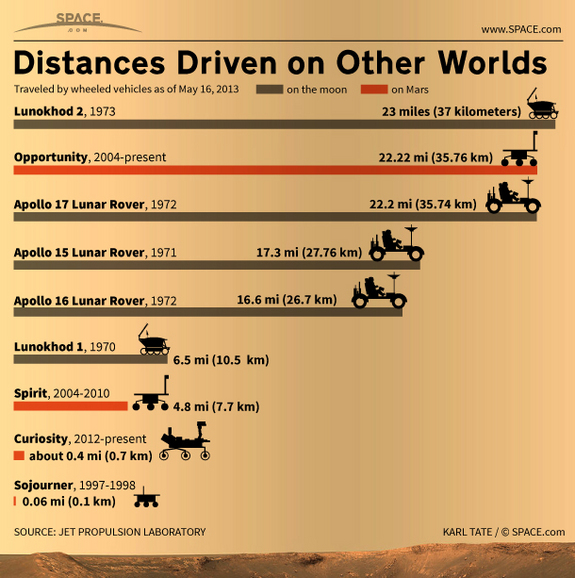
NASA's Opportunity Mars rover has started scaling the tallest hill it has yet encountered in its nearly 10 years of Red Planet exploration.
Opportunity is working its way up "Solander Point," the northern tip of a 130-foot-tall (40 meters) hill on the rim of Mars' Endeavour Crater. The rover is currently studying rocky outcrops that lie between 6.5 feet and 20 feet (2 to 6 m) above the surrounding plains, and it may climb higher in the coming days and weeks, NASA officials said.
"This is our first real Martian mountaineering with Opportunity," Opportunity principal investigator Steve Squyres, of Cornell University, said in a statement. "We expect we will reach some of the oldest rocks we have seen with this rover — a glimpse back into the ancient past of Mars." [Latest Mars Photos from NASA's Opportunity Rover]
The Opportunity rover began climbing Solander Point on Oct. 8 and has gone higher and higher on three additional drives since then, mission officials said. The rocks in Solander's upper reaches are older than those below because they were lifted up by the impact event that created Endeavour Crater.
Opportunity arrived at Solander Point in August after a long drive from another part of Endeavour's rim called "Cape York," where the rover worked for 20 very productive months. Mission scientists have high hopes for Solander as well.
"At Cape York, we found fantastic things," Squyres said. "Gypsum veins, clay-rich terrain, the spherules we call newberries. We know there are even larger exposures of clay-rich materials where we're headed. They might look like what we found at Cape York, or they might be completely different."
During its time in the Solander area, Opportunity has already studied a transition zone between two geological formations, the younger of which records evidence of a wet but very acidic ancient environment. Further study of the older rocks could shed light on when conditions changed, mission scientists said.
Sign up for the Live Science daily newsletter now
Get the world’s most fascinating discoveries delivered straight to your inbox.

In addition to its scientific potential, Solander Point provides a good place for Opportunity to wait out the southern hemisphere Martian winter, which will peak in February. Solander's slopes are north-facing, allowing Opportunity to tilt its solar panels toward the sun to catch precious but dwindling rays.
"We're in the right place at the right time, on a north-facing slope," Opportunity project manager John Callas, of NASA's Jet Propulsion Laboratory in Pasadena, Calif., said in a statement.
The coming winter will be the sixth endured by the golf-cart-size Opportunity, which landed on Mars in January 2004, three weeks after its twin, Spirit. Spirit was declared dead in 2011, but Opportunity is still going strong.
During most of its previous Martian winters, Opportunity was stationary for several consecutive months, soaking up the sun on a north-facing slope. But it should be able to stay mobile for much of this next winter because Solander offers so much north-facing area, mission officials said.
Four NASA rovers have explored the Red Planet over the years — Sojourner (which landed in 1997), Spirit, Opportunity and the car-size Mars rover Curiosity (which touched down in August 2012).
Recent drives by Curiosity and Opportunity have taken the NASA rover fleet's total odometry on Mars over 50 kilometers (31 miles), NASA officials said. As of Monday (Oct. 21), the total Red Planet driving distance for all four rovers was 31.13 miles (50.10 km), with Opportunity responsible for the vast majority — 23.89 miles (38.45 km).
Follow Mike Wall on Twitter @michaeldwall and Google+. Follow us @Spacedotcom, Facebook or Google+. Originally published on SPACE.com.











